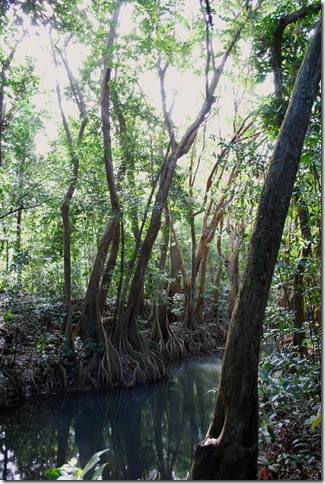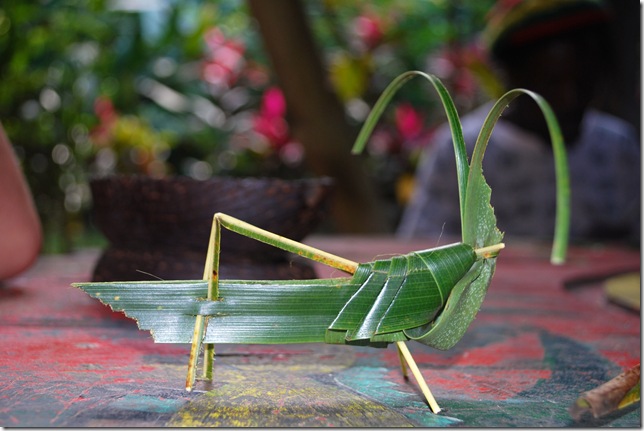Light winds and rain have been the order of the day lately. We left the Saints in a drizzle and made our way to Basse-Terre to check out on our way to Deshaies, our last anchorage in Guadeloupe. What should have been a simple stop to check-out during (French customs) business hours turned into an unexpected adventure. There’s supposed to be a customs office at Marina de Sens as well as in the main town, but after motoring into the marina and finding it packed and the fuel dock occupied, we decided to stop at the main town a mile and a half away, thinking there would be a better chance of finding someone in the office there anyway. The anchorage off of the town wasn’t the best, the commercial dock was empty, and the swell wasn’t too big, so we found a convenient spot to tie up to the dock and got permission to stay long enough to check out. My basic French eventually got me to the customs office where they told me sorry, go back to the marina. Can’t check out yachts here. I walked back to the marina, but didn’t see a customs office, so I asked around and was told to go to the Barracuda Restaurant. Not typical, but OK. I walked to the other side of the marina and found it was a very nice place with uniformed chefs and cooks getting ready for the lunch rush in a kitchen that was visible from the dining area. It turns out the main chef is also the customs guy. After checking several boiling pots on the stove, he took me into a closed Billabong-style surf wear shop next door, powered-up the computer used to as a cash register, and printed up my clearance after I’d filled in the form. Checking in and out can sometimes be a bit of an annoyance, but it’s never a bore.
We haven’t been fishing much, so I stopped on the way back to buy some fish at the market. Freshly caught mahi mahi, wahoo, tuna, and marlin were out on the chopping block and I got a pretty decent deal on some mahi mahi and wahoo. With Lauren’s parents coming to Antigua it will be nice to have fresh fish dinners at something other than the tourist price. Just to give an idea of the difference, I picked up enough mahi mahi and wahoo for about 9 servings, each larger than what you’d get in a restaurant for a little over $30 US. The restaurant at the dockyard here in Antigua is charging $45 US for one plate of wahoo.
When I got back to the boat I found out Lauren had been having an adventure as well. The swell had grown and docklines had chafed through while she was below. She was a little shaken up by the experience of colliding with the concrete wall (no real harm done, fortunately), but she had us tied back up securely and in a few minutes we were off for Deshaies.
We made Deshais before sunset. It’s one of those anchorages that almost everybody stops at on their way up or down the chain. We’re still getting used to the number of boats in the Caribbean and how tightly they get packed into anchorages. Deshaies had plenty of room for everyone, but it was still closely packed with 45 sailboats as well as a few local dive boats.
Thanks to light winds, our passage up to Antigua the next day was pretty uneventful. We even used the time to fill diesel tanks and Lauren gave the cockpit and deck a good cleaning. As we motored into Antigua’s English Harbour, we got a new lesson in what “crowded anchorage” means. This is Classic Regatta week and Antigua Sailing Race Week is coming up. The result is more boats and dinghies than we’ve ever seen in one place.
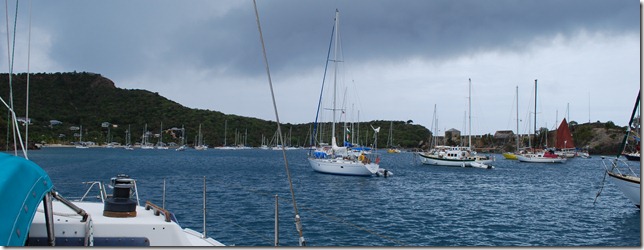 Looking from where we’re anchored across the channel toward Freeman Bay
Looking from where we’re anchored across the channel toward Freeman Bay
After checking in, we went ashore to do a little exploring and soon found ourselves in the middle of a party. We were walking down the street toward Falmouth Harbour when we saw Tracey walking toward us. She’d just arrived from Brazil by plane and we started catching up as we headed toward the yacht club. As full as English Harbour is, Falmouth Harbour made it look like a deserted backwater. The docks were jammed full of superyachts, mostly classic-style sailboats, including the ultra-modern square-rigged Maltese Falcon by Pereni Navi. There was a separate “harbour” just for dinghies from the armada of sailboats anchored and moored in the bay. The first part of the night’s festivities were sponsored by some European watch maker I’d never heard of, who must sell watches for the price of cars. They must be that expensive because their ads were just pictures of huge yachts and they took the opportunity to supply free drinks to everyone in the Harbour.
Mt. Gay sponsored the next portion of the evening with live music, cheap food, and cheap or free rum. The coveted red Mt. Gay hats were distributed to regatta participants and I was able to talk my way into a few of them after explaining that we’d sailed nearly 30,000 miles just to visit the Mt. Gay distillery in Barbados. The Caribbean is filled with a different type of sailor than the more remote anchorages of the Pacific and Indian Oceans. There are some old salts here, but there are also lots of charterers, people with a lot more money than sense or experience, boat bums who found an anchorage they won’t leave for 20 years or more (I’m not sure what some of them did with the money from selling their mast), European cruisers just starting to get nice and salty after crossing the Atlantic, Americans in shiney decked-out boats here for a run up and down the island chain, superyachts with uniformed crews that polish and clean then polish and clean some more, families, you name it. Everyone is represented here.
With so many different people around, we had to do a bit of mingling. Here’s a sampling of some of the people I enjoyed conversations with. It gives some feel for who’s here in addition to the owners and crew of the large, classic yachts: a Brit who lived aboard here for 20 years after retiring, a German owner/captain who charters his 60-foot sailboat for a route that covers the Med, the Caribbean, the Baltic, and St. Peterburg Russia, a local Rasta-style farmer with 3.5 acres that is mostly fruits and vegetables, but also includes a certain herb that he tries to sell at evening tourist gatherings, an American hiding from his ex-wife’s divorce lawyers for a few more years, a Swede who crossed the Atlantic with a partner and is now planning to head for the Panama Canal and attempt a circumnavigation, and a young man named Mario.
Mario was probably my favorite. He was born in Jamaica but has lots of family in the US and England, including a son in NYC. He’s working with a local company who is a distributor for Mt. Gay, so he was technically on the clock last night, but had plenty of time to chat. He left Jamaica because of all the violence in the cities and the lack of any job prospects after completing welding school. He’s had no problem fitting in and making friends here in Antigua and likes the more relaxed atmosphere. Since he was from Jamaica, we had to have a chat about music. While we’ve found that American hip-hop is popular the world-over, we were really surprised by how strong of an appeal Bob Marley still has to indigenous peoples and former slaves of all ages everywhere we’ve been. After reading Michener’s Caribbean over the last couple of weeks, it’s obvious that in addition to being a good musician, Marley captured quite eloquently the experiences and psyche shared by a lot of people after coming into contact with European society. Mario laughed and called Marley “old people” or “family” music. He’s right about that being the case here in the Caribbean. We like to listen to the local radio when we’re approaching a new country, and the music here even today is striking for its content. In the US, the girl you’re dancing with or the guy you’re in love with, or “bling” as Mario added, makes up for most of the lyrical content. The Caribbean has that too, but here there are also a lot of songs about life’s hardships, economic problems, politics and the government, etc. We even heard one really strange (for us) song on the bus in Dominca by a victim of childhood sexual abuse that passengers were singing along to. Mario just nodded his head vigorously and became a little animated when he said the difference is because in the US “you don’t have no hardships, no walkin’ to school with no shoes, no comin’ home and momma don’t have no food to give you to eat, no havin’ to go out in the street and rob someone just to have some food to eat.” In the US we think of much of the rest of the world as “poor” and behind, but really it’s just that we’re rich and lucky. Compared to much of the rest of the world, we’re more like the few guys with the crewed superyachts. Here in Antigua Mario’s had it much better. He’s got a good job, a girlfriend he’s thinking about proposing to, and enough money to soup up a Honda Civic and pay the tickets he gets for driving way too fast on the winding roads.
Dominica is one of the lesser known islands of the Caribbean as it has no international airport, has none of the resorts that are plentiful on most of the other islands, and is generally less developed. However, the “Nature Island” does have a reputation for eco-tourism, and we were anxious to take advantage of the river tours offered in Portsmouth. This was not hard to arrange, as our “boat boy”, Eric Spaghetti, happened to be a river tour guide. We made arrangements with him for a tour on Saturday morning before heading ashore for a bite to eat at one of the bayside’s open-air restaurants with sand floors and wood tables. On the menu were Jamaican dishes along with the usual snacks and seafood offerings, but the prices were obviously set at the tourist rate. No wonder we didn’t see any locals in there.
When we awoke on Saturday, we heard the sounds of reggae being blasted through the bay. Apparently some of the local partiers were still at it from the night before. Fortunately Eric wasn’t one of them, and he showed up to pick us up for our tour looking quite chill as he apparently always does. He motored over to the Indian River, which was surrounded by lush swamplands full of palm and banyon trees and other foliage that looked awesome set against the blue sky. He casually rowed us through the river, pointing out various flora (lilies and crotons) and fauna (herons and crabs) and answering our questions about the history of the island. Dominica was granted independence from Britain relatively recently (1979, I think?) and without struggle, according to Eric. He said after the Brits had taken what was valuable, they were done with the island. (He didn’t specify what was taken besides lots of tropical produce.) When asked what he thought about the current government, he simply said “half and half.”
After about an hour of rowing, Eric stopped at an open-air cafe of sorts along the river. There we met another Dominican who was carving coconut shells with a saw and gluing them together to make bowls. We took a walk around admiring the natural beauty and sipping on a coconut punch. We then returned to the cafe to find that Eric had artistic talents as well, as he presented us with two amazing origami-type creations that he made using palm leaves. He then rowed us back out the way we came, well at least part of the way. Dallas decided to have a go at rowing the wooden skiff and kept at it for quite a while despite that it was a little harder than expected.
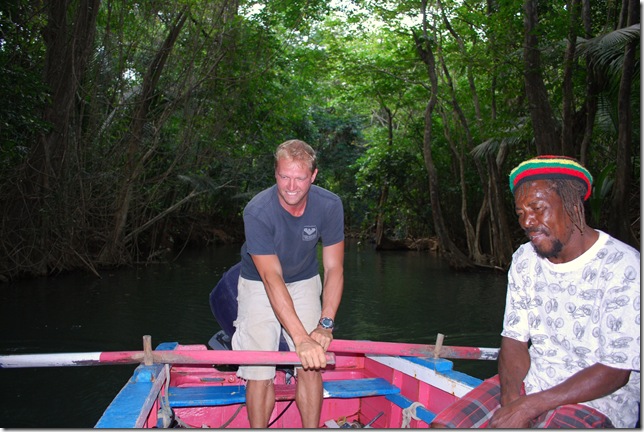 Eric’s chilling while Dallas gets a work out
Eric’s chilling while Dallas gets a work out
After a trip to the Saturday market and a mid-day rest, we decided to see if we could get over to the east side of the island to check out the Carib Indian reservation. The Caribs were once plentiful in the Caribbean but are now a much smaller group of a few thousand who have agreed to live in this particular area of the island. Eric acted like getting there would be “no problem” (just like everything else in his world, I think), and suggested that we could take a bus or hitch-hike. We found a bus going to the east side of the island, though not all the way to the Carib territory, and hopped on. It was PACKED full of people and groceries, flowers, etc. that they had purchased at the Saturday market, so it was a slow but very pleasant trip. Unlike the bus in Barbados, the Dominicans were very friendly to each other, and some sang along to the music played by the bus driver.
We took the bus as far as it went (Marigot) and received instructions as to how to walk the rest of the way. We were told that we could get to Carib territory in an hour or so from there, but it was a hot day and well into the afternoon, so we decided to try to hitch a ride. It wasn’t long before we were picked up by two very nice Dominican young ladies. They were obviously from the city (Roseau) and thought it was pretty odd that we were hiking to Carib territory. They informed us that we had a long way to go yet, and we expressed our gratitude for the lift. When they stopped to change a flat tire, we met their friend George and later learned that the women were helping him to deliver a rental car to a guest house in Carib territory. Anyway, George decided that as it was getting to be late afternoon, it was better for Dallas and I to ride along with them than to take our chances walking around and try to find a way back to Portsmouth in the evening. Locals know best, so we gratefully accepted his offer. Somehow we manage to meet helpful people everywhere we go!
George took us to a village that was created as a replica of a traditional Carib village with thatched-roof huts and old tools such as one used to mash sugar cane. Some Carib women were there making and selling baskets out of a plant fiber (that we can’t recall the name of) that was dyed various colors. The craftsmanship was impressive, so it was no sacrifice to buy a couple to donate to their tribe. Other than this “village”, however, one would hardly know that the Carib territory was any different from the rest of the outer island, and we could kind of understand why the ladies were so surprised that we had put so much effort into getting there. I explained to them that we had sailed thousands of miles on a small boat and were used to doing strange things. It all made sense to them after that!
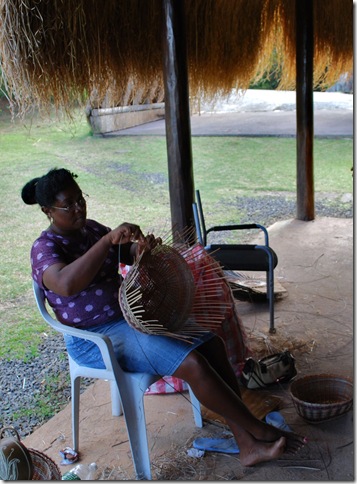 Caribs are known for fishing and basket weaving
Caribs are known for fishing and basket weaving
I really enjoyed the beauty and culture of Dominica and would be happy to return someday. We are now at anchor in the largest bay of The Saints, which is part of Guadeloupe, another French island. The village here is lovely with brightly painted houses, each with carefully maintained landscapes of flowers and other foliage. We have enjoyed two relaxing (though rainy) days here (hooray for high-speed internet!) and will continue to make our way north tomorrow in order to meet my parents in Antigua!
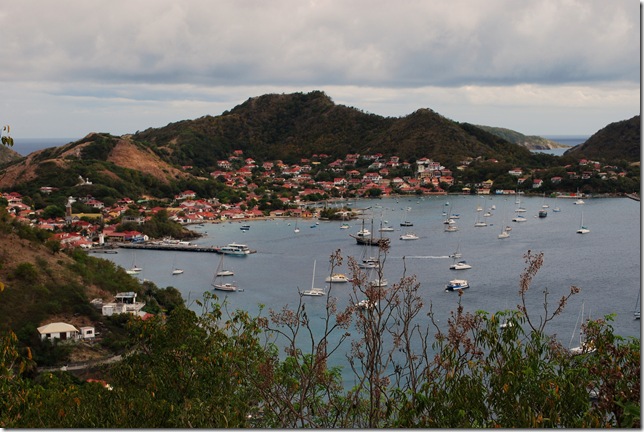 After a nice hike through the village, I had a nice view of PV (the far right) and the crowded anchorage at The Bay of the Saints
After a nice hike through the village, I had a nice view of PV (the far right) and the crowded anchorage at The Bay of the Saints


